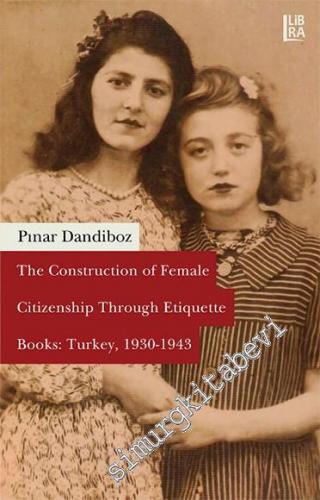#smrgKİTABEVİ The Construction of Female Citizenship Through Etiquette Books: Turkey, 1930 - 1943 - 11

Accordingly, not only the citizen's dress and deportment, but also the citizen's body and sexual life were to be completely renewed. On the other hand, while the books were defining the “acceptable” citizen, women were taken as an important measure of compliance. Thus, as the symbols of the new and modern life, women's appearance, manners, and all feminine pursuits became signifiers of the social status of modern Turkish men. Consequently, this book reveals that the class and gender dimensions of etiquette books are not independent of each other, but intersect and support one another.
İçindekiler
Chapter 1 - INTRODUCTION
Chapter 2 - HEORETICAL FRAMEWORK
2.1. Foucault
2.2. Elias
2.3. Bourdieu
Chapter 3 - WESTERN, OTTOMAN, AND REPUBLICAN NOTIONS OF ETIQUETTE
3.1. Historical Development of European Etiquette Literature
3.2. Etiquette from the Ottoman Era to the Republic
3.3. Etiquette Books and Authors, 1930-1943
3.4. Overview of Republican Etiquette, 1930-1943
Chapter 4 - GENDER AND CITIZENSHIP
4.1. Gender and Citizenship in Turkey
4.1.1. The Ottoman Period
4.1.2. The Republican Period
Chapter 5 - CLASS AND GENDER ISSUES IN TURKISH REPUBLICAN ETIQUETTE BOOKS
5.1. Physical Appearance
5.1.1. Rules for Dressing
5.1.2. Personal Grooming / "Toilette"
5.2. Etiquette in Public
5.2.1. Rules for the Street
5.3. Etiquette and Society Life
5.3.1. Rules for Entertainment, Balls and Dances
5.3.2. Etiquette for Visits, "At Home" Days, and Tea Parties
5.3.3. Dinner Parties
5.3.4. Table Manners
5.3.5. Rules for the Decoration of the House
5.4. Etiquette and Personal Issues
5.4.1. Sexuality and Marriage
5.4.2. Rules for Relationships between Men and Women
5.4.3. Etiquette and Family Life
5.5. The Ideal of Feminine Conduct in Family Life
5.5.1. Woman as Mother
5.5.2. Woman as a Wife
5.5.3. Woman as a Housewife
5.5.4. Household Management: Domestic Economy, Domestic Household
5.6. Women and Work
5.7. Girls and Education
Chapter 6 - CONCLUSION
BIBLIOGRAPHY
INDEX
Accordingly, not only the citizen's dress and deportment, but also the citizen's body and sexual life were to be completely renewed. On the other hand, while the books were defining the “acceptable” citizen, women were taken as an important measure of compliance. Thus, as the symbols of the new and modern life, women's appearance, manners, and all feminine pursuits became signifiers of the social status of modern Turkish men. Consequently, this book reveals that the class and gender dimensions of etiquette books are not independent of each other, but intersect and support one another.
İçindekiler
Chapter 1 - INTRODUCTION
Chapter 2 - HEORETICAL FRAMEWORK
2.1. Foucault
2.2. Elias
2.3. Bourdieu
Chapter 3 - WESTERN, OTTOMAN, AND REPUBLICAN NOTIONS OF ETIQUETTE
3.1. Historical Development of European Etiquette Literature
3.2. Etiquette from the Ottoman Era to the Republic
3.3. Etiquette Books and Authors, 1930-1943
3.4. Overview of Republican Etiquette, 1930-1943
Chapter 4 - GENDER AND CITIZENSHIP
4.1. Gender and Citizenship in Turkey
4.1.1. The Ottoman Period
4.1.2. The Republican Period
Chapter 5 - CLASS AND GENDER ISSUES IN TURKISH REPUBLICAN ETIQUETTE BOOKS
5.1. Physical Appearance
5.1.1. Rules for Dressing
5.1.2. Personal Grooming / "Toilette"
5.2. Etiquette in Public
5.2.1. Rules for the Street
5.3. Etiquette and Society Life
5.3.1. Rules for Entertainment, Balls and Dances
5.3.2. Etiquette for Visits, "At Home" Days, and Tea Parties
5.3.3. Dinner Parties
5.3.4. Table Manners
5.3.5. Rules for the Decoration of the House
5.4. Etiquette and Personal Issues
5.4.1. Sexuality and Marriage
5.4.2. Rules for Relationships between Men and Women
5.4.3. Etiquette and Family Life
5.5. The Ideal of Feminine Conduct in Family Life
5.5.1. Woman as Mother
5.5.2. Woman as a Wife
5.5.3. Woman as a Housewife
5.5.4. Household Management: Domestic Economy, Domestic Household
5.6. Women and Work
5.7. Girls and Education
Chapter 6 - CONCLUSION
BIBLIOGRAPHY
INDEX





















